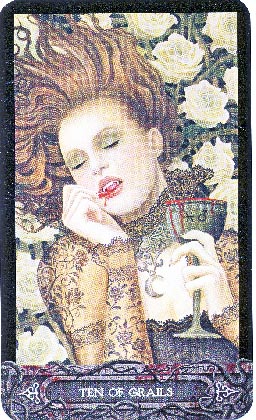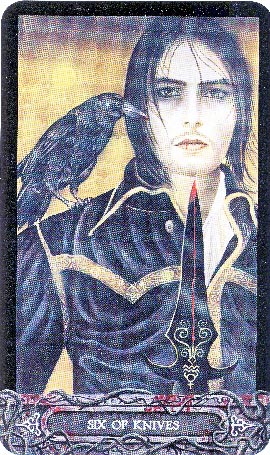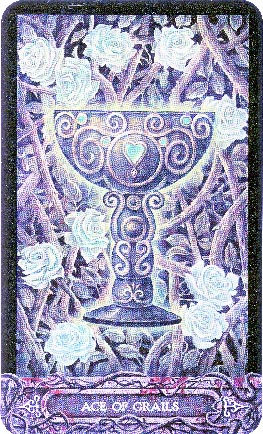
This new tarot deck and book set is certain to be popular with children of the night whether they know how to read tarot or not. The artwork is calculated to appeal to Goths and vamps, so sales should be brisk.
But a review’s primary purpose isn’t to soliciting sales; it’s about examining a tarot deck or book and giving an assessment of its merit or lack thereof. And theme decks can be a tricky balancing act for a deck designer. Does The Tarot of Vampyres have merit? My initial reaction the deck was one of horror and revulsion as I saw the familiar patterns of the tarot serving this dark, blood-thirsty tribe. Then it occurred to me that anything I disliked that much on sight demanded a deeper look, not only for the sake of fairness, but also to plumb the roots of my distress.
The Tarot of Vampyres is based on the Book of Thoth but not on the Crowley-Harris Thoth Tarot. The Court cards are Lord, Queen, Prince and Daughter. The trump cards are unnumbered and retain card titles Temperance and the World (rather than Art and the Universe, as in the Thoth deck). The suits are all renamed: Scepter (Wands); Knives (Swords); Grails (Cups); and Skulls (Coins/Pentacles), and the astrological glyphs are integrated into the imagery.
I found it very necessary to read the accompanying book, “Phantasmagoria.” Here the ties to the Book of Thoth are evident. Daniels opens with a history of vampirism, an overview of the Golden Dawn’s kabalistic, elemental and astrological attributions, and a series of tarot spreads and exercises. There are instructions for creating a Personal Card Portrait. The remainder of the book treats the divinatory meanings of the cards. Thorough descriptions give each card’s attributions, divinatory meanings, and further insights into the card and the imagery. The final “Shadow” section treats the dark side of the card, which applies to reversals if they are used. The card meanings are a well-written update of the Book of Thoth, and a useful supplement to other Thoth-style decks.
This is still not a light, happy deck. Departing from the RWS or Thoth symbolism isn’t a sacrilege in my book, but the imagery should convey some glimmer of meaning, and this is sometimes a problem. For example, in the Ten of Grails, a vampyress dressed in black lace licks the blood off of her lips as she lies on a bed of white roses. The divinatory meaning is given as “Emotional wholeness and harmony. Home and family. Settlement. An end of tensions and hostilities…” Well, yes, I might manage to have that look of orgiastic ecstasy if I’d just sucked my worst enemy dry. I had a very hard time associating this image with emotional wholeness or home and family. It would make more sense to me if there were a group of clan-banging vamps having a suck-fest.
As an entirely separate issue, the art is mostly, but not always, well done. The close-up portraits are a showcase of the artist’s best work. Six of Swords The Aces are well designed and consistent. The action scenes sometimes miss the mark, as in the Five of Scepters. The relentless darkness of the cards sometimes makes it hard to see details.
The source of my nagging unease is a sense of imbalance. Light is necessary for shadows; in order to survive, vampires need people. There are few people and very little light in this deck. The main theme of vampiric lore is the struggle for humans to survive and preserve their humanity, while vampires remain in the shadows, unseen and unchallenged in their predatory quests. Had that struggle been integrated as an illustrated storyline, the deck would feel more balanced. A human standing in the light of the rising sun in the Sun card would have been very satisfying. This deck saturates the reader in a dark world of vampires garbed in the apparel, symbols and icons of the subculture, and the flaw (for me) is that there’s no relief from it.
The book has separate merit as an updated exposition of the Book of Thoth. The artwork is good and sometimes exceptional. But all of these separate elements don’t necessarily add up to a deck with lasting appeal. It’s a deck that reflects the obsessions of a subculture, and so speaks to them; but it may not speak well to others. More often than not, the decks with staying power are the ones that do a good job of conveying the card meanings effortlessly, without reliance on a book.
~review by Elizabeth Hazel
Author/ Artist: Ian Daniels
Llewellyn Worldwide
301 pp, $28.95


